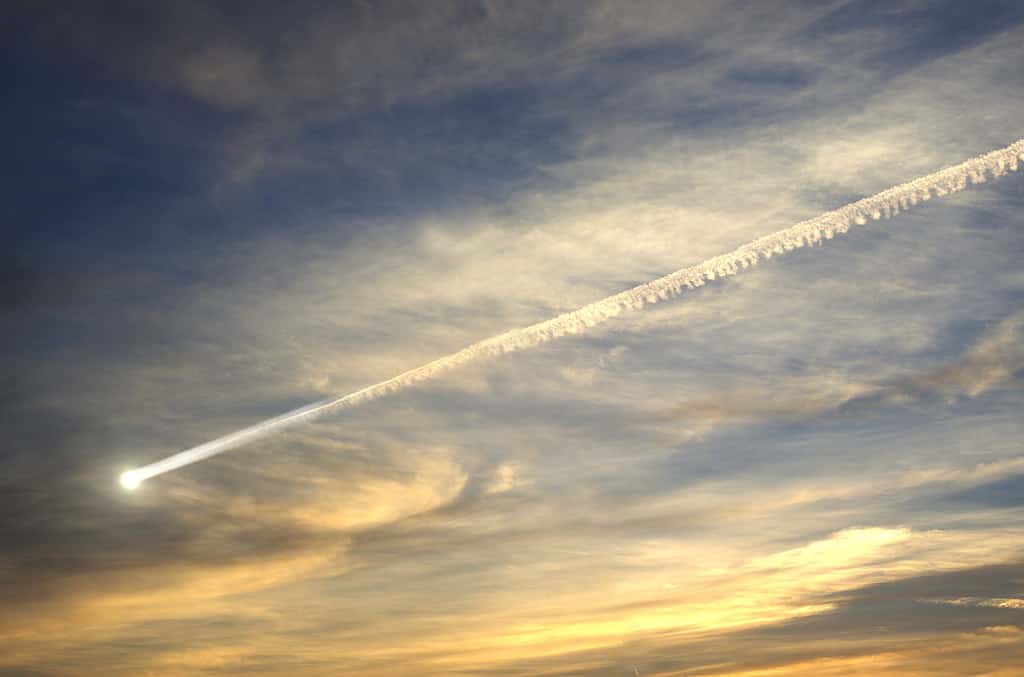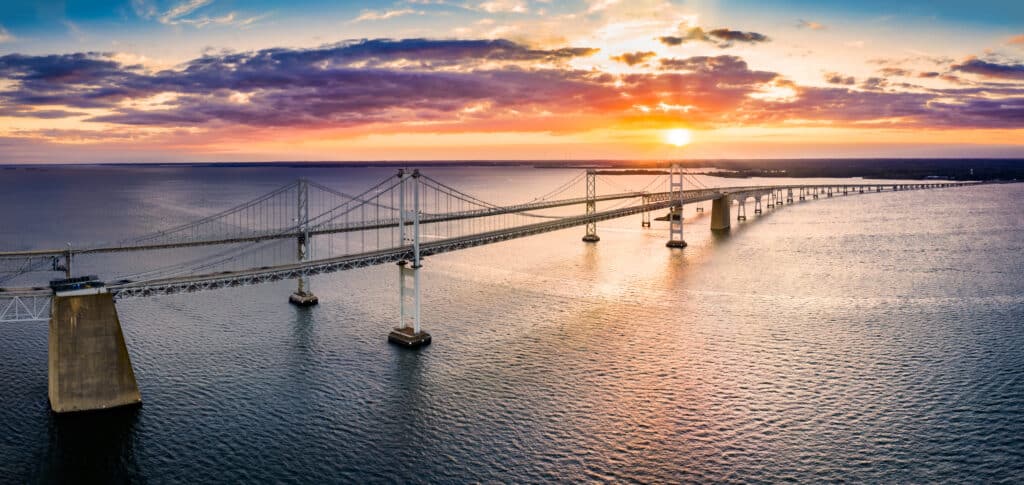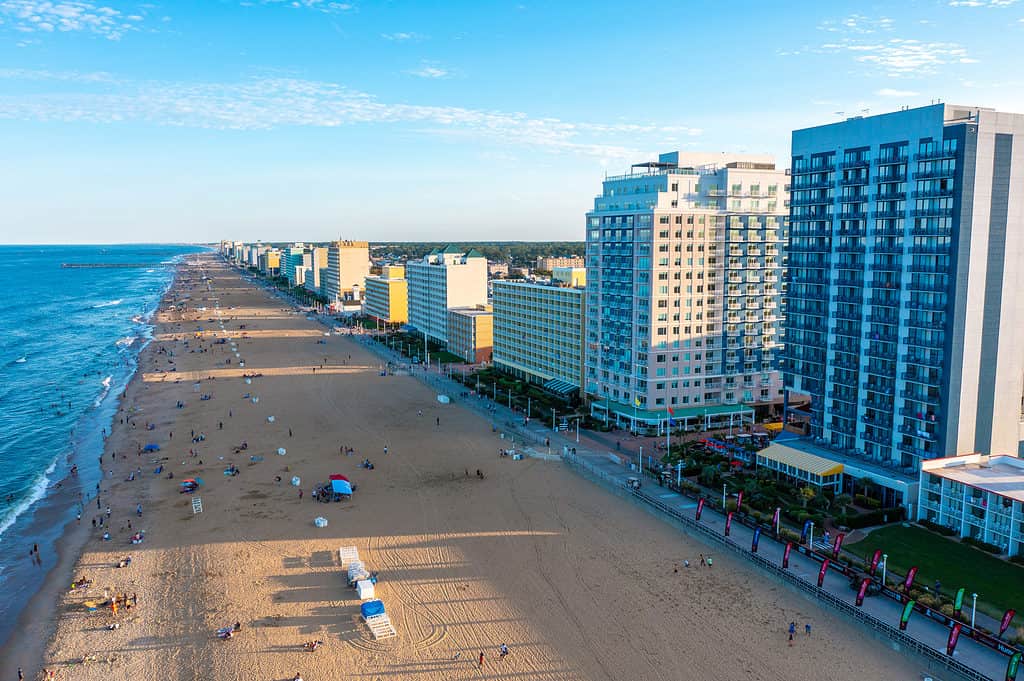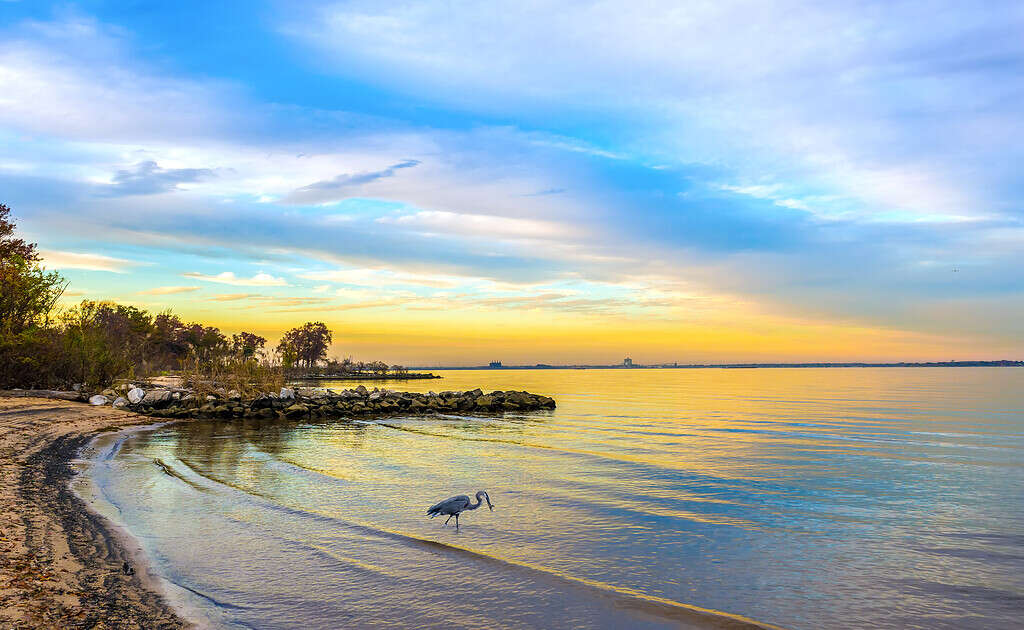We live in a universe that is constantly moving and changing. Galaxies spin away from each other in a significant expansion. Comets and asteroids often visit solar systems like ours and collide with the planets in their paths. Moons or natural satellites which orbit the planets in our system sometimes shield them from these impacts. However, some get through and hit the atmosphere with a tremendous explosion, sometimes causing a crater on the planet’s surface. To learn more about these events, let’s look at the biggest impact crater in Virginia.

Meteor explosions can cause large impact craters.
©Krasowit/Shutterstock.com
The Biggest Impact Crater in Virginia
The Chesapeake Bay has the biggest impact crater in Virginia. It is located at the mouth of the Chesapeake Bay. It is over 55 miles wide, though some of that is due to erosion and sediment slumping. Geologists estimate that the original impact crater was closer to 25 miles across. A giant meteor exploded in the atmosphere over the Eastern seaboard of North America about 35.5 million years ago and created the impact crater.
The meteor collided with our atmosphere at about 11 miles per second. The resulting explosion blasted through sediment and fractured the granite basement rock to a depth of 5 miles. The explosion instantly vaporized the meteor.
The Biggest Impact Crater in Virginia Is in Chesapeake Bay
The impact crater has helped the Chesapeake Bay become an important part of the ecology of Virginia and Maryland. It created a topographic depression that took in the waters of rivers in the Chesapeake region. This created the largest estuary in the United States. Over 150 rivers and streams make their way into the bay’s drainage basin. The Delmarva Peninsula, which includes portions of Virginia, Maryland, and Delaware, shelters it from the Atlantic Ocean. The bay measures about 200 miles from the Susquehanna River to its outlet off the coast of Virginia Beach.

The Chesapeake Bay Impact Crater is the biggest in Virginia.
©Mihai_Andritoiu/Shutterstock.com
Hampton Roads Metropolitan Area
The body of water which channels the James, Nansemond, and Elizabeth rivers into the Chesapeake Bay, near the impact crater, is known as Hampton Roads. This is also the name of the metropolitan area, which includes Chesapeake, Norfolk, Newport News, Virginia Beach, VA, as well as other towns, cities, and villages of North Carolina. The Hampton Roads metropolitan area is known for shipyards, its military presence, coal piers, miles of waterfront beaches, and property. Many consider it to be the world’s greatest natural harbor. Let’s look at some of the Hampton Roads cities in Virginia around the impact crater.
Chesapeake
Chesapeake, VA, has a population of nearly 250,000. It is the second-most populous city in Virginia and the tenth-most populous in the Mid-Atlantic. Voters organized it in 1963 by referendum. The city has a few urban areas but also farmland, forests, and a portion of the Great Dismal Swamp. Economically, it has industrial, commercial, and residential waterfront properties.
Newport News
Newport News has a population of over 185,000 and is the fifth-largest city in Virginia by population. This area was once one of the original shires of Virginia formed in the British Colony of Virginia in 1634. The city’s economy is tied to the military. Many residents work in shipbuilding and with various military bases and suppliers.
Norfolk
Norfolk, VA, has a population of about 238,000 and is the third-most populous city in the state. Incorporated in 1705, Norfolk has long been a strategic military and transportation hub, having many miles of waterfront property. Naval Station Norfolk, the world’s largest naval base, is located there. It is also considered the Hampton Roads region’s cultural, financial, historical, and urban center.
Virginia Beach
The most populous city in Virginia, Virginia Beach has a population of over 450,000 and is Hampton Roads’ largest city. Located on the coast at the mouth of the Chesapeake Bay, Virginia Beach was the landing site of the first English colonists. They later settled in Jamestown. The city is a resort city with extensive beaches and numerous hotels. Virginia Beach has the longest pleasure beach in the world, listed in the Guinness Book of World Records.

Virginia Beach, VA, is on the edge of the Chesapeake Bay Impact Crater—the biggest impact crater in Virginia.
©iStock.com/Kyle Little
Wildlife Near Chesapeake Bay
The Chesapeake Bay is at the confluence of over 150 rivers and streams and the Atlantic Ocean. It is a boon to wildlife along the coast. Mammals include the black bear, mink, bobcat, skunk, porcupine, opossum, white-tail deer, raccoon, flying squirrel, coyote, fisher, woodchuck, and red and gray foxes. A few bat species, like the evening bat and the little brown bat, live throughout the region.
Of course, many birds live here. Osprey, great blue herons, peregrine falcons, and bald eagles call these lands home. The piping plover (near threatened) resides in the local wetlands.
It’s no surprise that the bay area is home to over 300 species of fish, shellfish, and crab. These include Atlantic menhaden, striped bass, oysters, horseshoe crabs, and blue crabs. Larger fish include Atlantic sturgeon, bull sharks, tiger sharks, scalloped hammerhead sharks, basking sharks, stingrays, and manta rays.
Seasonally, bottlenose dolphins reside in the bay. Whales, including the North Atlantic right whale, fin, minke, and sei whales, have been seen there, too. There are also unconfirmed reports of humpback whales making an appearance. Loggerhead turtles also frequent the bay.

The Chesapeake Bay Impact Crater created ideal conditions for the formation of the Chesapeake Bay. Diverse wildlife are attracted to the shores of Virginia.
©iStock.com/flownaksala
The Biggest Impact Crater in Virginia: Where It Is on a Map
Conclusion
Although initially destructive, the meteor that created the Chesapeake Bay Impact Crater is responsible for a thriving ecosystem. It also created the world’s greatest natural harbor.
The photo featured at the top of this post is © solarseven/Shutterstock.com
Thank you for reading! Have some feedback for us? Contact the AZ Animals editorial team.







